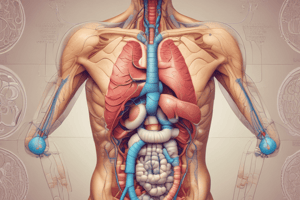Podcast
Questions and Answers
What is the primary function of peristalsis in the gastrointestinal tract?
What is the primary function of peristalsis in the gastrointestinal tract?
- Mixing food with enzymes and acids
- Waves that move a bolus through the tract (correct)
- Regulating the rhythmic cycles of smooth muscle activity
- Churning and fragmenting a bolus
Which of the following neurons serves as the pacemaker for smooth muscle contractions in the gastrointestinal tract?
Which of the following neurons serves as the pacemaker for smooth muscle contractions in the gastrointestinal tract?
- Enteric neurons
- Autonomic neurons
- Sensory neurons
- Interstitial cells of Cajal (correct)
What is the primary role of the enteric nervous system in regulating gastrointestinal motility?
What is the primary role of the enteric nervous system in regulating gastrointestinal motility?
- Regulating the contraction of smooth muscle (correct)
- Modulating the activity of interstitial cells of Cajal
- Releasing hormones to stimulate smooth muscle contraction
- Stimulating the parasympathetic nervous system
What is the primary function of segmentation in the gastrointestinal tract?
What is the primary function of segmentation in the gastrointestinal tract?
Which of the following is NOT a factor that influences gastrointestinal motility?
Which of the following is NOT a factor that influences gastrointestinal motility?
What is the primary role of the parasympathetic nervous system in regulating gastrointestinal motility?
What is the primary role of the parasympathetic nervous system in regulating gastrointestinal motility?
What is the primary function of sphincter tone and relaxation in the gastrointestinal tract?
What is the primary function of sphincter tone and relaxation in the gastrointestinal tract?
What is the primary role of the autonomic nervous system in regulating gastrointestinal motility?
What is the primary role of the autonomic nervous system in regulating gastrointestinal motility?
What is the primary function of the neural enterogastric reflex in regulating gastric emptying?
What is the primary function of the neural enterogastric reflex in regulating gastric emptying?
Which hormone stimulates the secretion of HCO3- and inhibits stomach activity?
Which hormone stimulates the secretion of HCO3- and inhibits stomach activity?
What is the primary function of the short reflexes operating in the enteric nervous system (ENT)?
What is the primary function of the short reflexes operating in the enteric nervous system (ENT)?
What is the primary function of Motilin in regulating gastric activity?
What is the primary function of Motilin in regulating gastric activity?
What is the primary function of the long reflexes operating via the CNS in regulating gastric activity?
What is the primary function of the long reflexes operating via the CNS in regulating gastric activity?
What is the primary function of GIP (gastric inhibitory peptide) in regulating gastric activity?
What is the primary function of GIP (gastric inhibitory peptide) in regulating gastric activity?
What is the primary function of CCK (cholecystokinin) in regulating gastric activity?
What is the primary function of CCK (cholecystokinin) in regulating gastric activity?
What is the primary function of the local reflex pathway in the gastrointestinal tract?
What is the primary function of the local reflex pathway in the gastrointestinal tract?
Flashcards are hidden until you start studying
Study Notes
Overview of the Digestive System
- MBBS Year 1 Gastrointestinal Lectures cover topics such as digestion and absorption of nutrients, salivary, gastric, and pancreatic secretions, bile and biliary system, and motility of the gut.
Motility of the Gut
- Gastric smooth muscle contractions facilitate the breakdown of ingested food.
- Pacemaker cells (Interstitial Cells of Cajal) serve as pacemakers for muscle contraction in the GI tract.
- Neural and hormonal stimuli regulate gastric motility.
Functions of Motility
- Mixing: Smooth muscle contraction mixes food with digestive enzymes.
- Propulsion: Smooth muscle contraction propels food through the digestive tract.
Gastrointestinal Tract Smooth Muscle Contractile Activity
- Visceral smooth muscle shows rhythmic cycles of activity.
- Pacemaker cells (Interstitial Cells of Cajal) generate rhythmic activity.
- Peristalsis: Waves that move a bolus through the digestive tract.
- Segmentation: Churn and fragment a bolus.
- Sphincter tone and relaxation: Regulate the passage of food through the digestive tract.
Factors Influencing Gastrointestinal Tract Motility
- Smooth muscle functional syncytium: Electrical activity of muscle cells generates slow waves (pacemaker potentials) and spike potentials, resulting in contraction.
- Neural control: Autonomic and enteric nervous systems regulate GI tract motility.
- Hormonal control: Endocrine (gastrin, CCK) and local (paracrine, neurocrine) hormones regulate GI tract motility.
Gastric Contractile Activity
- Most vigorous peristalsis and mixing occur near the pylorus.
- Chyme is either delivered in small amounts to the duodenum or forced backward into the stomach for further mixing.
Regulation of Gastric Emptying
- Gastric emptying is regulated by neural enterogastric reflex and hormonal (enterogastrone) mechanisms.
- These mechanisms inhibit gastric secretion and duodenal filling.
- Carbohydrate-rich chyme quickly moves through the duodenum, while fat-laden chyme is digested more slowly, causing food to remain in the stomach longer.
Regulation of Gastric Activity
- Hormonal control: Secretin, CCK, GIP, and motilin regulate gastric activity.
- Neuronal control: Short reflexes operating in the enteric nervous system (ENT) inhibit gastric secretion/contraction, while long reflexes operating via the CNS alter autonomic nerve activity.
Studying That Suits You
Use AI to generate personalized quizzes and flashcards to suit your learning preferences.




